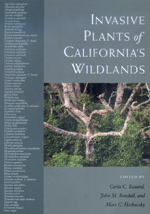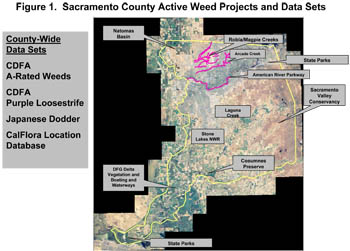MOU | Cooperating Groups | Strategic Plan | Projects | Resources
General contact: Zachary Skalak, 916-268-3344, skalakz@saccounty.gov
Meetings: Quarterly at the Sacramento County Regional Parks Office
10361 Rockingham Drive, Sacramento, CA 95827
(Currently via Zoom since March 2020)
MOU
The Sacramento Weed Management Area Memorandum of Understanding (MOU) establishes the terms and conditions under which the WMA collaborates and coordinates activities necessary to prevent the introduction, establishment, and spread of harmful invasive weeds in Sacramento County. These activities focus on prevention, detection, and management of priority invasive weeds.
The MOU fosters interagency cooperation with federal, state and local agencies, watershed-based groups and private landowners in activites that contribute to the stated objectives. Download the MOU here (pdf, 2 MB).
COOPERATING GROUPS
- American River Parkway Foundation
- California Department of Food and Agriculture
- California Department of Transportation (CalTrans), District 3
- California Native Plant Society, Sacramento Valley Chapter
- California State Parks, Gold River Dist.
- California Department of Fish & Wildlife
- Effie Yeaw Nature Center
- Florin Resource Conservation District
- Friends of Folsom Parkway
- Laguna Creek Watershed Council
- Natural Resources Conservation Service, Elk Grove Service Center
- PG&E
- Sacramento Area Flood Control Agency
- Sacramento County Agricultural Commissioner
- Sacramento County Department of Regional Parks
- Sacramento County Department of Water Resources
- Sacramento County Transporation Department
- Sacramento Municipal Utilities District
- Sacramento Regional County Sanitation District
- Teichert
- The Nature Conservancy, Cosumnes River Preserve
- U.S. Bureau of Reclamation, Central California Area Office
- U.S. Fish and Wildlife Service – Stone Lakes Preserve
- Wilbur Ellis
STRATEGIC PLAN
Download the Sacramento WMA Strategic Plan here (PDF)
Download the Sacramento WMA Strategic Plan Appendices here (PDF)
Strategic Plan Mission & Vision:
- The Sacramento County WMA will reduce the introduction and spread of invasive weeds through coordination and cooperation between signatory groups. The WMA will focus on preventing introduction of new weeds and stopping the expansion of existing populations through control and education projects.
Goals:
- Protect and enhance the native biodiversity of Sacramento County ecosystems.
- Maintain and increase the profitability and value of cropland and rangeland.
- Maximize the effectiveness of vegetation management activities and reduce the cost of roadside, park, and waterway maintenance.
- Enhance the recreation experience throughout the County.
- Reduce fire hazard and fire control costs in the County.
- Encourage research and coordination on effective weed management techniques.
Strategies for Accomplishing Goals:
- Education: Raising Awareness and Outreach
- Prevention: Exclusion and Early Detection
- Information Management: Survey, Inventory and Mapping
- Projects: Weed Management, Restoration, Monitoring and Research
- Administration: Project Funding, WMA Administration and Partnerships
Priority Weeds:
| SACRAMENTO WMA HIGH PRIORITY WEEDS | |||
|---|---|---|---|
| Scientific Name | Common Name | Cal-IPC Rank/ CDFA Rating |
Notes |
| Acroptilon repens | Russian knapweed | Mod/B | Few locations along roadsides and fields in Natomas Area |
| Arundo donax | Giant reed | High/B | Priority for management in riparian areas. |
| Centaurea solstitialis | Yellow starthistle | High/C | Management in high quality habitat and recreation areas. |
| Chondrilla juncea | Skeleton weed | MOD/A | Not a priority for mapping and control in Sacramento or foothill counties according to CDFA, weed of concern for counties around Sacramento |
| Cuscuta japonica | Japanese dodder | –/A | Active eradication program in place. |
| Cytisus scoparius | Scotch broom | High/C | Not much of this, keep on priority list, abundant in upstream watersheds. |
| Dittrichia graveolens | Stinkwort | MOD*/NL | Project priority. This weed is the subject of a mapping and eradication program started in 2009. |
| Eichornia crassipes | Water hyacinth | High*/C | Priority in Delta waterways, still actively sold in nurseries. |
| Genista monspessulana | French broom | HIGH/C | Scattered locations, sometimes sold in nursery trade, upstream of American River Parkway. |
| Lepidium latifolium | Perennial pepperweed | High/B | Heavy infestations in the southern part of the County, spreading along roadsides and through contaminated materials. |
| Ludwigia spp. | Water primrose | HIGH/NL | Project priority. Eradication target for mosquito and vector control work. Spreading in agricultural ditches and Laguna Creek |
| Sapium sebiferum | Chinese tallow | MOD*/NL | Starting to naturalize in the American River Parkway, Dry Creek and other riparian areas. |
| Sesbania punicea | Red sesbania | HIGH*/B | Project priority. Target of active eradication program in Dry Creek, abundant in Steelhead, Robla and Arcade creeks. |
| Spartium junceum | Spanish broom | High/C | Scattered locations in American River Parkway, sometimes sold in nursery trade. |
Status Definitions
Cal-IPC Ranks (Cal-IPC Inventory Categories) definitions can be located here.
CDFA Rating definitions can be located here.
Weed Watch List:
| SACRAMENTO WMA WEED WATCH LIST | |||
|---|---|---|---|
| Scientific Name | Common Name | Cal-IPC Rank/ CDFA Rating |
Notes |
| Ailanthus altissima | Tree of Heaven | MOD/C | Concern in natural areas. |
| Centaurea calcitrapa | Purple starthistle | MOD/B | A few recorded locations, more abundant in Solano County. |
| Centaurea sulphurea | Sicilian starthistle | –/B | Expanding outside known location in Folsom. |
| Cynara cardunculus | Artichoke thistle | MOD/B | In southern Delta, could expand north. |
| Glyceria declinata | Manna grass | MOD/NL | Invading vernal pools. |
| Lythrum salicaria | Purple loosestrife | HIGH/B | Small populations are not being actively managed. |
| Robinia pseudoacacia | Black locust | LIMITED/NL | Concern in riparian areas. |
| Rubus (armeniacus) discolor | Himalaya blackberry | HIGH/NL | Concern in high-value habitats, widespread. |
| Taeniatherum caput-medusae | Medusahead | HIGH/C | Widespread, concern in high quality rangeland in eastern County. |
| Tamarisk sp. | Tamarisk | HIGH – VAR/B | Only a few populations on American River Parkway, could become more widespread. |
| Tribulus terrestris | Puncture vine | NL/C | Concern to bikers, abundant along Sacramento River bike trail. |
WMA Priority Action Items from 2009 Strategic Plan:
- Develop list of horticultural plants of concern in Sacramento County
- Develop an outreach and education strategy linked to prevention, exclusion and early detection
- Develop preliminary Early Detection Rapid Response (EDRR) action plan
- Upgrade the available weed data to a more user-friendly format such as Google Earth
- Work with grant writer and WMA members to find additional funding sources
- Coordinate land management groups to more effectively manage weeds
- Hold one field meeting per year
- Coordinate efforts with Bay Area Early Detection Network (BAEDN)
PROJECTS
Laguna Creek Watershed Weed Management Program
- Tamarisk, Chinese tallow, pampassgrass, giant reed, water hyacinth, milk thistle and yellow starthistle were removed from six locations within the Laguna Creek Watershed by volunteers and professionals. Weed mapping was extended to include the Upper Laguna Creek Corridor. Additionally a weed monitoring training workshop was conducted for the Elk Grove Unified School District and local scout group leaders.
Robla Creek Mapping & Weed Removal
- Initiated in 2008, this project targets the removal of mature and seedling red sesbania infestations throughout Robla, Magpie and Steelhead Creeks. In addition, volunteer removed over one million seed pods within these waterhsheds in just two years. Download 1-page project summary here.
Effie Yeaw Nature Center Weed Reduction
- This project focused on removing weeds from two-acres surrounding the Effie Yeaw Nature Center. Weed removal in this area improved wildlife habitat, increased the Nature Center’s ability to educate the public about natrual enviromnets and reduced the threat of wildfire for the Nature Center. Download 1-page project summary here.
Merten Ranch yellow starthistle control
- 100 acres of yellow starthistle were treated using a helicopter herbicide application, in a cost-share between the owner of Merten Ranch and the Sacramento WMA.
American River Parkway
- The WMA funded the purchase of weed removal tools like weed wrenches for weed removal work on the American River Parkway. Weeds like yellow starthistle, red sesbania, and arundo were mapped using GPS and aerial photos. A controlled burn for yellow starthistle was also carried out. The WMA worked with the Sacramento Weed Warriors to complete the project.
RESOURCES

Brochures
- WMA Brochure
- Japanese Dodder
- Red Sesbania (created by the Sacramento Weed Warriors)
- Chinese Tallow (created by the Sacramento Weed Warriors)
- Arundo (created by the Sacramento Weed Warriors)
- Spanish Broom (created by the Sacramento Weed Warriors)
- Pampas Grass (created by the Sacramento Weed Warriors)

